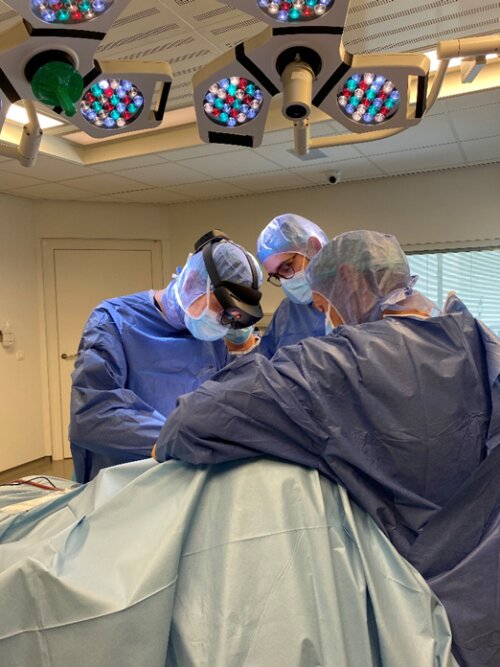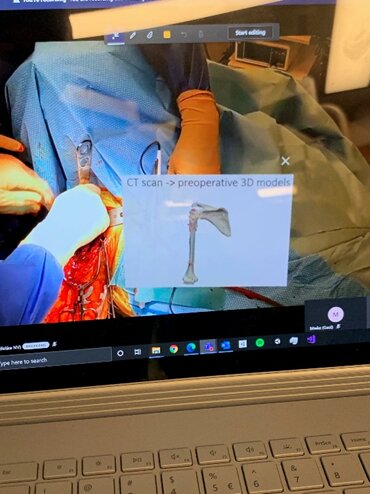Watching a surgery through the surgeon's own eyes
During the COVID-19 pandemic, the OR had closed their doors for visitors. In normal circumstances students and physiotherapists could visit the OR to watch a surgery, to gain insight in the techniques to optimize their treatment strategy. What could we do?
Unfortunately visiting the OR was not possible during a global pandemic due to safety measures. Of course there were still a lot of students and physiotherapists, among others, wanting to learn from surgeons during a surgery, instead of learning from videos. Prof. Dr. Olivier Verborgt (AZ Monica & UZA) started thinking and decided to use Augmented Reality in the OR.
What? How?
“Isn’t Augmented Reality only used to play video games?” No, Augmented Reality is not the same as Virtual Reality. Augmented reality uses a real-world setting, while Virtual Reality is virtual, using a fictional reality. This means the surgeon performed surgeries wearing glasses which made an online audience see everything he saw, and hear everything that was said. Students and physiotherapist could, in this way, visit the OR to watch a surgery from their couch at home.


Another feature that was used during these surgeries were holograms. The surgeon could show different images, such as radiographic images or pictures of an implant, in the room. He just needed to pinch his finger and draw the image closer. In this way, the audience could not only see what was happening in the body, but could also watch what it was supposed to be and get insight in every aspect of the surgery.

The past year we organised a few online classrooms where students and physiotherapists could attend. The surgeon performed shoulder prosthesis surgeries and taught the online audience using this Augmented Reality technology.
What did the audience think?
We send out a questionnaire after each online classroom. We asked about the quality of live stream, quality of sound, visibility of holograms, and their overall experience. The audience rated every of these things as very good. There average experience was even rated 85 out of 100. Almost 90% of attendants believes they could improve their treatment strategies because of this online classroom.
What did the surgeon think?
“The use of new technology has increased tremendously over the last decade. In orthopaedic surgery, we now use several applications on a daily base to improve our patient care and make surgical outcomes better. The “new kid on the block” is the Hololens that offers the surgeon literally a different view on his patient. Today we are using it mostly for teaching purposes in live class-rooms for physiotherapists. Sharing operative techniques and how soft tissues are handled improves their understanding of the surgery, and helps them to improve the rehabilitation process and final result. In the very near future shoulder surgeons will even be able to use AR and robotics to assist them in implanting shoulder prosthesis components.” – Prof. Dr. Olivier Verborgt
Future?
This online experience showed a lot of opportunities for the future. For example, a physiotherapist who has to travel one or two hours to the hospital to watch a live surgery could now watch it from home. The OR will also be less crowded which makes it more comfortable for the staff. Being part of this project was an amazing opportunity and hopefully we will organise more and more online classrooms to teach (future) physiotherapists about surgeries.
Research and teaching assistant (Research group MOVANT, Department of Rehabilitation Sciences and Physiotherapy (REVAKI), University of Antwerp)